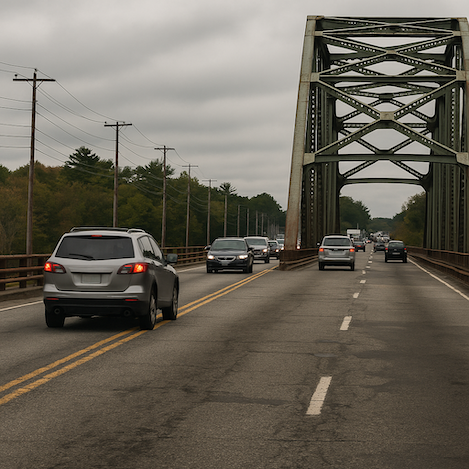Why Maine’s Older Bridges Are Becoming Accident Hotspots

Drivers across Maine travel over hundreds of bridges every day — often without realizing how old many of them are. From the Androscoggin River crossings in Lewiston to the Piscataqua River Bridge linking Maine and New Hampshire, these structures are vital to our state’s transportation network. But as they age, they’re also becoming increasingly dangerous.
Crashes involving poor bridge design, icy surfaces, and failing infrastructure have risen in recent years, raising serious questions about safety and accountability.
Maine’s Bridges Are Aging Faster Than They’re Being Repaired
According to the Maine Department of Transportation (MaineDOT), the state maintains over 2,400 public bridges, many of which were built more than 50 years ago. More than one-third are rated “fair” or worse under federal inspection standards.
While MaineDOT continues to prioritize repairs, the scale of the problem is daunting. Decades of exposure to salt, frost, and heavy truck traffic have left many bridges deteriorating faster than they can be replaced.
A 2024 federal infrastructure report ranked Maine among the top ten states with the highest percentage of structurally deficient bridges. That means many of the bridges Mainers use daily are showing significant wear — cracked concrete, corroded supports, and weakened guardrails.
These structural issues don’t just pose an engineering problem — they create real-world hazards that can lead to catastrophic crashes.
Why They Create Dangerous Conditions
Older bridges often lack the safety features now required on newer structures. These deficiencies can increase the risk of collisions, especially during Maine’s harsh winters.
Some of the biggest safety challenges include:
- Narrow lanes: Many mid-20th-century bridges were built before today’s larger vehicles and commercial trucks became common. Tight lanes leave little room for error.
- Lack of shoulders: When a car breaks down or a driver loses control, there’s often nowhere to pull over safely.
- Poor drainage: Aging drainage systems cause ice buildup and slick surfaces, particularly on elevated spans that freeze before the rest of the roadway.
- Low or weak guardrails: Outdated railings may not withstand the impact of modern vehicles, increasing the risk of vehicles plunging into rivers or embankments.
- Abrupt transitions: Uneven pavement at bridge approaches can cause drivers to lose control, especially at high speeds or in low visibility.
Combined, these factors turn older bridges into high-risk zones — particularly during storms, at night, or when drivers are distracted or speeding.
Recent Related Accidents in Maine
While some crashes on Maine bridges are minor, others have had devastating results. In recent years:
- A car lost control on the Penobscot Narrows Bridge after striking ice, leading to a multi-vehicle chain reaction.
- On a deteriorating span in Aroostook County, a pickup truck veered off the edge after a guardrail failed to hold.
- Near Augusta, poor drainage caused a patch of black ice that sent two vehicles into oncoming lanes.
Each of these incidents demonstrates how infrastructure neglect, combined with Maine’s extreme weather, creates perfect conditions for tragedy.
Who Can Be Held Liable for a Bridge Accident?
Determining liability after a bridge-related crash can be complex. Depending on the circumstances, several parties may share responsibility:
- Government agencies or contractors that failed to maintain or inspect the bridge properly.
- Private construction firms that performed negligent repair or resurfacing work.
- Drivers who acted carelessly or ignored posted warnings.
- Trucking companies that exceeded weight limits or caused structural strain.
If poor maintenance or design contributed to an accident, injured victims may have the right to file a personal injury or wrongful death claim under Maine law. These cases often involve public entity liability, which means special notice requirements and shorter filing deadlines — making early legal action essential.
How Bridge Defects Affect Injury Claims
Bridge accident cases often hinge on whether a dangerous condition existed and whether responsible parties knew — or should have known — about it.
For example, if MaineDOT or a contractor was aware that a bridge surface repeatedly froze over or that a guardrail failed inspection but didn’t take action, that could constitute negligence. Similarly, if warning signs were missing or maintenance was delayed, victims may have a strong case for compensation.
Recoverable damages may include:
- Medical expenses and rehabilitation costs
- Lost wages and reduced earning capacity
- Pain, suffering, and emotional distress
- Property damage
- In wrongful death cases, funeral and loss-of-companionship damages
Preventing Bridge-Related Crashes
While drivers can’t control the condition of Maine’s bridges, they can take steps to reduce their risk:
- Slow down when crossing bridges in rain, snow, or ice.
- Avoid tailgating — icy bridges make sudden stops dangerous.
- Stay alert for posted weight limits or “Bridge Freezes Before Road” signs.
- Report hazards like crumbling concrete or missing guardrails to MaineDOT.
Simple caution can make the difference between a safe trip and a serious accident.
How Peter Thompson & Associates Can Help
At Peter Thompson & Associates, we’ve represented Maine drivers injured due to dangerous roads, poorly maintained bridges, and government negligence. Our firm investigates every aspect of these complex cases — from engineering reports to maintenance logs — to identify exactly where the system failed.
We understand how difficult it can be to face government agencies or large contractors alone. That’s why our attorneys handle every step, from preserving evidence to negotiating with insurers or pursuing litigation in court.
If you or a loved one has been injured in a bridge-related crash in Maine, don’t wait. Contact Peter Thompson & Associates for a free consultation today. We’ll fight for the answers, accountability, and compensation you deserve.

